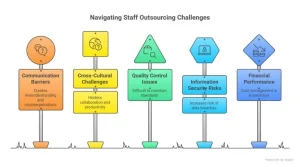It adds significant benefits to the businesses to outsource staff. However, it is not without challenges. These can be communication, cultural, and other barriers that become obstacles for businesses to outsource staff seamlessly.
Listed below are some of the common challenges of staff outsourcing likely to be faced by organizations when they outsource their workforce.
These, in turn, help you to avoid the very mistakes of taking a step toward outsourcing staff for your business. On the other hand, understanding these challenges of outsourcing will help a business make an informed decision on how to avoid or mitigate potential risks.
Now, going into the details, let us discuss any issues that could arise in outsourcing staff. In short, you will explore the staff outsource solutions.
Communication Barriers in the Company
Communication barriers are important to eliminate. The outsourced team might be from another country or speak their native language. So, it is difficult to adjust in a company where a communication gap exists.
Cross-Cultural Business Challenges
A language barrier is one of the common staff outsourcing issues encountered. Hence, language differences can lead to misunderstandings and misinterpretations. Different communication styles, working habits, and expectations also act as collaboration barriers. Additionally, coordinating work across different time zones can be challenging.
Quality Control Issues
Maintaining standards is difficult when outsourcing staff. Ensuring consistent quality and service levels can be difficult when working with external providers. Knowledge transfer is also a hurdle. Effectively transferring knowledge and company culture to the outsourced team can be challenging. To measure performance, establishing clear KPIs and monitoring performance can be complex.
Information Security Risks at the Company
For every business, data privacy is of utmost importance. It is crucial to protect customer and employee information. The risk of data breaches is also an important aspect. Outsourcing can increase the risk of data breaches if proper security measures are not in place.
Financial Performance Optimization
Cost management is a major constraint when it comes to outsourcing staff. Managing costs effectively to ensure that outsourcing is a profitable decision. Be sure about the hidden costs. Identifying and addressing potential hidden costs associated with outsourcing.
Integration Difficulties
System compatibility is essential when outsourcing staff. The outsourcing provider must be compatible with your company’s systems. Another important aspect is a cultural fit—the culture of the outsourcing partner should align with your values and goals.
Governance and Oversight Challenges in Business
For outsourced contracts and SLAs, contract management is crucial. Those risks associated with outsourcing have to be mitigated and identified.
Workforce Engagement and Retention
If not managed properly, outsourcing can negatively impact employee morale. The employees may feel that there is job insecurity due to outsourcing.
Managing Outsourcing Partnerships
Maintain and build strong relationships with outsourcing providers. Performance evaluation is mandatory. Regularly assess the performance of the outsourcing partner. Dispute resolution must be considered. You must have mechanisms in place to address and resolve disputes.
Businesses can manage their outsourcing relationships. It can help them maximize the benefits of this strategy. It is achievable by understanding and addressing these challenges of Staff Outsourcing.

Overcoming Outsourcing Challenges
We share some of the techniques that help you overcome the challenges of staff outsourcing:
Building Strong Communication Channels
- Regular communication: Establish clear communication channels with the outsourcing provider.
- Dedicated point of contact: Assign a dedicated person to manage the outsourcing relationship.
- Cultural training: Provide cultural training to both in-house and outsourced teams.
Fostering Cultural Understanding
- Cultural awareness: Educate both teams about cultural differences and expectations.
- Cross-cultural training: Consider providing cross-cultural training programs.
- Open communication: Encourage open and honest communication to address misunderstandings.
Implementing Robust Quality Assurance Processes
- Clear expectations: Define clear quality standards and expectations.
- Regular monitoring: Monitor the outsourcing provider’s performance against agreed-upon KPIs.
- Feedback mechanisms: Establish feedback mechanisms to address issues and improve quality.
Prioritizing Data Security
- Comprehensive security measures: Ensure that the outsourcing provider has strong data security measures in place.
- Regular audits: Conduct regular security audits to identify and address vulnerabilities.
- Data privacy agreements: Establish clear data privacy agreements to protect sensitive information.
Effective Cost Management Strategies
- Regular reviews: Review and renegotiate contracts as needed.
- Cost analysis: Track and analyze costs to identify areas for optimization.
- Hidden costs: Be aware of potential hidden costs and factor them into your budget.
Seamless Integration Planning
- System compatibility: Ensure that the outsourcing provider’s systems integrate seamlessly with your internal systems.
- Data migration: Plan for a smooth data migration process.
- Change management: Address any organizational changes associated with outsourcing.
Maintaining Control and Transparency
- Regular reporting: Require regular reports on the outsourcing provider’s performance.
- On-site visits: Conduct periodic on-site visits to assess operations.
- Risk management: Develop a risk management plan to address the potential challenges of staff outsourcing
Mitigating Employee Concerns
- Open communication: Address employee concerns and provide reassurance about job security.
- Training and development: Offer training and development opportunities to help employees adapt to changes.
- Involve employees: Involve employees in the outsourcing decision-making process.
Selecting the Right Outsourcing Partner
- Vendor selection criteria: Defining key factors to consider when choosing an outsourcing provider.
- RFP process: Creating a request for proposal (RFP) to evaluate potential vendors.
- Due diligence: Conducting thorough research and background checks on outsourcing providers.
Setting Clear Expectations and KPIs
- Service level agreements (SLAs): Establishing clear performance metrics and expectations.
- Regular reviews: Conducting periodic reviews to assess the outsourcing partner’s performance.
- Dispute resolution mechanisms: Defining procedures for resolving disputes or disagreements.
Managing Risk and Contingency Planning
- Risk assessment: Identifying potential risks and developing mitigation strategies.
- Contingency planning: Creating backup plans to address unforeseen challenges.
- Regular monitoring: Continuously monitoring the outsourcing relationship and making necessary adjustments.
FAQs for Challenges of Staff Outsourcing
What are the risks associated with staff outsourcing in UAE?
Risks include compliance issues with UAE labor laws, data security concerns, inconsistent quality, and dependency on vendors. Misaligned culture and hidden costs are also common.
How to maintain oversight and compliance when using outsourcing firms?
Use clear contracts, KPIs, and regular audits. Ensure transparency, limit system access, and review legal compliance frequently.
What are the quality and consistency issues when outsourced staff work remotely or off-site?
Remote staff may face supervision gaps, communication delays, and uneven work quality. Security risks and accountability issues can also arise.
How to ensure outsourced staff are aligned with company culture and values?
Help the new hires to integrate into the workforce effectively by providing proper onboarding, cultural training, and regular integration sessions. Encourage collaboration and include them in company updates.
What measures can employers implement to avoid misuse or underperformance in staff outsourcing?
Set performance-based KPIs, review regularly, and use milestone-based contracts. Keep escalation procedures and backup options ready.



